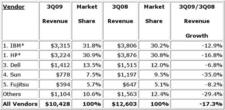Q3 2009: Blade Servers and x86 Leading Server Market
With a 1.2% growth, blade servers are leading all others in the market segment that may have made strides in the past. But the IDC research firm sees light at the end of the tunnel: since the bleak period that ended 2008, the revenue curve for the worldwide server market is trending upwards again.
Compared with 2008, the worldwide revenue for the server market declined 17.3% in the third quarter of 2009 to $10.4 billion, which makes the fifth consecutive quarter of a downturn. Server unit shipments fell by almost 18% year over year. Volume shipments fell by almost 15%, with midrange enterprise server revenue falling by more than 23%.
IDC emphasizes, however, that the negative trend in revenue and unit shipments is only half as bad as it was in 2Q09. The second quarter showed a decline of a little over 30%. The market research firm rates the Q3 figures in comparatively positive terms: revenue grew for the first time since 4Q08 and server shipments increased by 12.4% year over year, "the largest sequential unit growth since 2005."
 Vendor ranking in 3Q09: IBM slides a whisper ahead of HP since 2008 and Sun is hit comparatively the worst. (Source: IDC)
Vendor ranking in 3Q09: IBM slides a whisper ahead of HP since 2008 and Sun is hit comparatively the worst. (Source: IDC)
Linux servers grew in market share year over year by not quite one percent to 14.8%, with $1.5 billion total revenue among vendors and distributors. The increase was $200 million over the previous quarter, but still almost 13% less than 3Q08. In comparison, the UNIX server revenue came to $2.8 billion, a slight decline since Q2 and more than a 23% cut year over year, representing a market share of just under 27%. The largest revenue share came from Windows machines in 3Q09, with $4.5 billion, but with a similar year-over-year decline at just under 13% as the Linux servers.
IDC found that the x86 processor platform factory revenues grew by 18.7% from quarter to quarter, but still showed a drop of 12.3% year over year. The only growth factor seemed to be the blade server market: compared to last year, factory revenue actually grew by 1.2%, even though shipments declined by 14%. The results show a revenue growth for three quarters in a row, with blade servers the top growth market over the last six months. IDC attributes the blade server success to cost efficiencies due to next generation processors (Intel Nehalem) and increased RAM. Customers use blade servers for new, virtualized environments, considering them "closely associated technologies" and a driving force in the data center of the future.
Subscribe to our Linux Newsletters
Find Linux and Open Source Jobs
Subscribe to our ADMIN Newsletters
Support Our Work
Linux Magazine content is made possible with support from readers like you. Please consider contributing when you’ve found an article to be beneficial.

News
-
Parrot OS Switches to KDE Plasma Desktop
Yet another distro is making the move to the KDE Plasma desktop.
-
TUXEDO Announces Gemini 17
TUXEDO Computers has released the fourth generation of its Gemini laptop with plenty of updates.
-
Two New Distros Adopt Enlightenment
MX Moksha and AV Linux 25 join ranks with Bodhi Linux and embrace the Enlightenment desktop.
-
Solus Linux 4.8 Removes Python 2
Solus Linux 4.8 has been released with the latest Linux kernel, updated desktops, and a key removal.
-
Zorin OS 18 Hits over a Million Downloads
If you doubt Linux isn't gaining popularity, you only have to look at Zorin OS's download numbers.
-
TUXEDO Computers Scraps Snapdragon X1E-Based Laptop
Due to issues with a Snapdragon CPU, TUXEDO Computers has cancelled its plans to release a laptop based on this elite hardware.
-
Debian Unleashes Debian Libre Live
Debian Libre Live keeps your machine free of proprietary software.
-
Valve Announces Pending Release of Steam Machine
Shout it to the heavens: Steam Machine, powered by Linux, is set to arrive in 2026.
-
Happy Birthday, ADMIN Magazine!
ADMIN is celebrating its 15th anniversary with issue #90.
-
Another Linux Malware Discovered
Russian hackers use Hyper-V to hide malware within Linux virtual machines.
